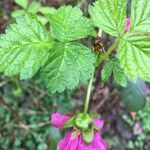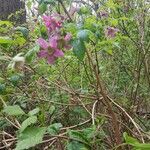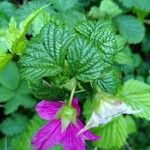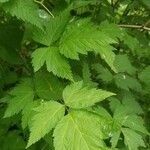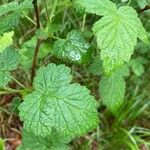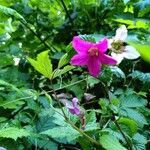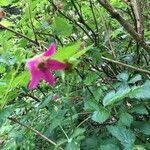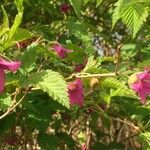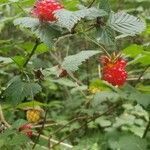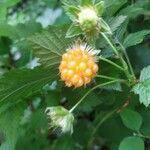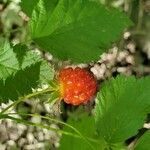Shrubs, 10–40 dm, usually armed. Stems erect to arching, glabrate or sparsely to densely hairy, eglandular or sparsely short-stipitate-glandular, rarely densely long-stipitate-glandular, not pruinose; ?bark usually papery with age, peeling (especially toward base)?; prickles absent or sparse to dense, erect, slender, 1–5 mm, broad-to narrow-based. Leaves deciduous, ternate; stipules filiform to linear, 3–10 mm; terminal leaflets ovate, 4–15 × 3.5–15 cm, base truncate, rounded to shallowly cordate, shallowly, sharply lobed, margins coarsely serrate to doubly serrate, apex acute to acuminate, abaxial surfaces unarmed or with erect prickles on midvein, moderately to densely hairy, eglandular, rarely stipitate-glandular along midvein. Inflorescences terminal and axillary, 1–2-flowered. Pedicels unarmed or prickles sparse, erect, moderately to densely hairy, eglandular, rarely short-stipitate-glandular. Flowers bisexual; petals pink to magenta, broadly to narrowly obovate, 10–30 mm; filaments laminar; ovaries glabrous. Fruits yellow, orange, or red, globose to ovoid, 1–2 cm; drupelets 20–80, strongly coherent, separating from torus. 2n = 14.
More
A prickly shrub. It grows 1.8 m tall and spreads 1.8 m wide. It loses its leaves during the year. The stems are upright. It has small thorns. The leaves have 3 egg shaped leaflets. The flowers occur singly and are pink or purple. The fruit is a berry which is edible. It is a yellow-pink colour.
Moist spots in and about woods; at elevations below 300 metres in California. Woodlands, woodland edges, bogs, shorelines, roadsides, disturbed areas, moist to wet soil; at elevations up to 2,000 metres.
More
It is a temperate plant. It grows in shaded swamps and damp woods. It suits hardiness zones 5-9.
Can be grown by cuttings or seedlings. Seeds needs stratification.
